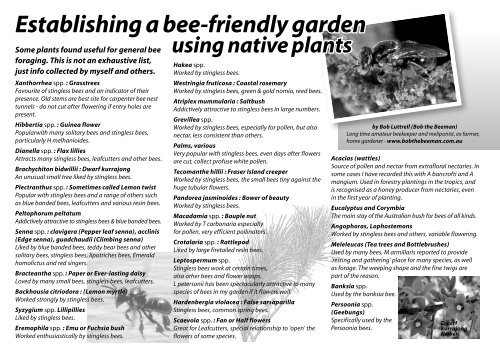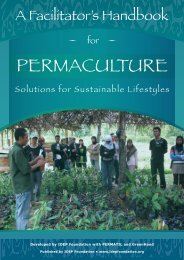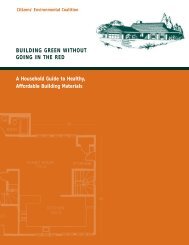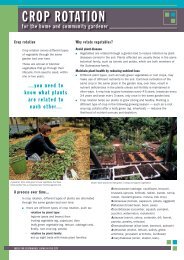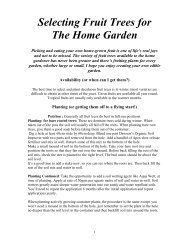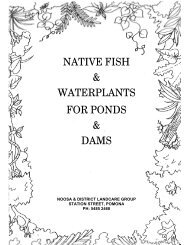Planting Trees to Attract Bees - Green Journey
Planting Trees to Attract Bees - Green Journey
Planting Trees to Attract Bees - Green Journey
Create successful ePaper yourself
Turn your PDF publications into a flip-book with our unique Google optimized e-Paper software.
Establishing a bee-friendly garden<br />
Some plants found useful for general bee<br />
foraging. This is not an exhaustive list,<br />
just info collected by myself and others.<br />
Xanthorrhea spp. : Grasstrees<br />
Favourite of stingless bees and an indica<strong>to</strong>r of their<br />
presence. Old stems are best site for carpenter bee nest<br />
tunnels - do not cut after flowering if entry holes are<br />
present.<br />
Hibbertia spp. : Guinea flower<br />
Popularwith many solitary bees and stingless bees,<br />
particularly H melhanioides.<br />
Dianella spp. : Flax lillies<br />
<strong>Attract</strong>s many stingless bees, leafcutters and other bees.<br />
Brachychi<strong>to</strong>n bidwillii : Dwarf kurrajong<br />
An unusual small tree liked by stingless bees.<br />
Plectranthus spp. : Sometimes called Lemon twist<br />
Popular with stingless bees and a range of others such<br />
as blue banded bees, leafcutters and various resin bees.<br />
Pel<strong>to</strong>phorum peltatum<br />
Addictively attractive <strong>to</strong> stingless bees & blue banded bees.<br />
Senna spp. : clavigera (Pepper leaf senna), acclinis<br />
(Edge senna), guadchaudii (Climbing senna)<br />
Liked by blue banded bees, teddy bear bees and other<br />
solitary bees, stingless bees, lipotriches bees, Emerald<br />
homolictus and red singers.<br />
Bracteantha spp. : Paper or Ever-lasting daisy<br />
Loved by many small bees, stingless bees, leafcutters.<br />
Backhousia citriodora : (Lemon myrtle)<br />
Worked strongly by stingless bees.<br />
Syzygium spp. Lillipillies<br />
Liked by stingless bees.<br />
Eremophila spp. : Emu or Fuchsia bush<br />
Worked enthusiastically by stingless bees.<br />
using native plants<br />
Hakea spp.<br />
Worked by stingless bees.<br />
Westringia fruticosa : Coastal rosemary<br />
Worked by stingless bees, green & gold nomia, reed bees.<br />
Atriplex mummularia : Saltbush<br />
Addictively attractive <strong>to</strong> stingless bees in large numbers.<br />
Grevillea spp.<br />
Worked by stingless bees, especially for pollen, but also<br />
nectar, less consistent than others.<br />
Palms, various<br />
Very popular with stingless bees, even days after flowers<br />
are cut, collect profuse white pollen.<br />
Tecomanthe hillii : Fraser Island creeper<br />
Worked by stingless bees, the small bees tiny against the<br />
huge tubular flowers.<br />
Pandorea jasminoides : Bower of beauty<br />
Worked by stingless bees.<br />
Macadamia spp. : Bauple nut<br />
Worked by T carbonaria especially<br />
for pollen, very efficient pollina<strong>to</strong>rs.<br />
Crotalaria spp. : Rattlepod<br />
Liked by large firetailed resin bees.<br />
Lep<strong>to</strong>spermum spp.<br />
Stingless bees work at certain times,<br />
also other bees and flower wasps.<br />
L petersonii has been spectacularly attractive <strong>to</strong> many<br />
species of bees in my garden if it flowers well.<br />
Hardenbergia violacea : False sarsaparilla<br />
Stingless bees, common spring bees.<br />
Scaevola spp. : Fan or Half flowers<br />
Great for Leafcutters, special relationship <strong>to</strong> ‘open’ the<br />
flowers of some species.<br />
by Bob Luttrell (Bob the Beeman)<br />
Long time amateur beekeeper and meliponist, ex farmer,<br />
home gardener - www.bobthebeeman.com.au<br />
Acacias (wattles)<br />
Source of pollen and nectar from extrafloral nectaries. In<br />
some cases I have recorded this with A bancrofti and A<br />
mangium. Used in forestry plantings in the tropics, and<br />
is recognised as a honey producer from nectaries, even<br />
in the first year of planting.<br />
Eucalyptus and Corymbia<br />
The main stay of the Australian bush for bees of all kinds.<br />
Angophoras, Lophostemons<br />
Worked by stingless bees and others, variable flowering.<br />
Meleleucas (Tea trees and Bottlebrushes)<br />
Used by many bees, M armillaris reported <strong>to</strong> provide<br />
‘resting and gathering’ place for many species, as well<br />
as forage. The weeping shape and the fine twigs are<br />
part of the reason.<br />
Banksia spp.<br />
Used by the banksia bee.<br />
Persoonia spp.<br />
(Geebungs)<br />
Specifically used by the<br />
Persoonia bees.<br />
Dwarf<br />
kurrajong<br />
flower


